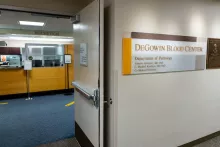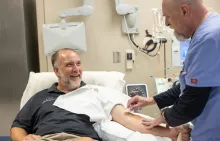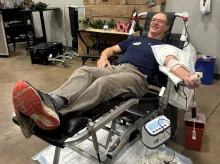DeGowin Blood Center Patient Services offers a full range of therapeutic procedures including plasma exchange, red blood cell exchange (or red blood cell depletion/exchange), photopheresis, cellular depletion, peripheral blood stem cell and mononuclear cell collection, and therapeutic phlebotomy. The blood center physicians provide consultative services to clinicians.
Peripheral Blood Stem Cell and Mononuclear Cell Collections
Stem cells are immature cells that grow and divide into mature red blood cells, white blood cells, or platelets. The type of blood cell that a stem cell will develop into is determined by the specific needs of the patient’s body.
Mononuclear cells include dendritic cells and T cells, and may serve as the starting material for production of individualized cellular therapies such as dendritic cell vaccines or chimeric antigen receptor (CAR) T cells. They are also sometimes used to treat patients who have had a prior hematopoietic stem cell transplant.
A peripheral blood stem cell or mononuclear cell collection is a procedure involving the separation and collection of a particular type of white blood cell from the blood.
Peripheral blood stem cell and mononuclear cell collections are performed using a machine called a blood cell separator. This machine uses a centrifuge to separate and collect these cells from the blood. The cells may be frozen for storage if necessary, until the patient is ready to receive the cells.
The DeGowin Blood Center also collects blood stem cells or mononuclear cells for the Iowa Marrow Donor Program (a Donor Center for the National Marrow Donor Program).
Therapeutic Patient Procedures
Apheresis involves removing whole blood and separating it into components. An automated cell separator is used and allows one or more of the components to be removed while the rest of the blood components are returned to the donor or patient.
Therapeutic apheresis involves removing a specific blood component as part of a patient’s treatment. The DeGowin Blood Center performs several types of therapeutic apheresis procedures.
- Plasmapheresis is a procedure that removes large amounts of plasma and replaces it with another fluid. Often the substances that need to be removed in the plasma are antibodies. Some illnesses treated with this procedure include thrombotic thrombocytopenic purpura (TTP), myasthenia gravis, acute or chronic inflammatory demyelinating polyneuropathy, and antibody-mediated solid organ transplant rejection.
- Red blood cell exchanges (or red blood cell depletion/exchanges) are performed to remove diseased red blood cells and replace them with healthy donor red blood cells. A patient with sickle cell disease may need this treatment.
- Photopheresis is a procedure that collects mononuclear white blood cells, treats them with psoralen, and exposes the cells to an ultraviolet light. These cells are then given back to the patient to regulate their immune system. This procedure is used to treat cutaneous T-cell lymphoma, graft versus host disease, and chronic lung transplant rejection.
- Therapeutic phlebotomy is the removal of a unit of blood from a patient to provide a health benefit to that patient. It is commonly used to treat polycythemia vera, hemochromatosis, and iron overload as the result of previous transfusions.
Locations and Offices


